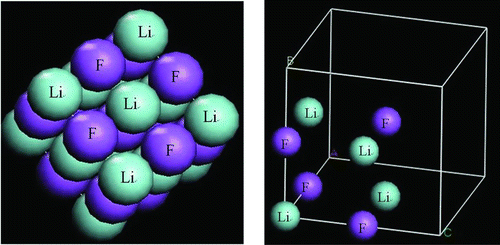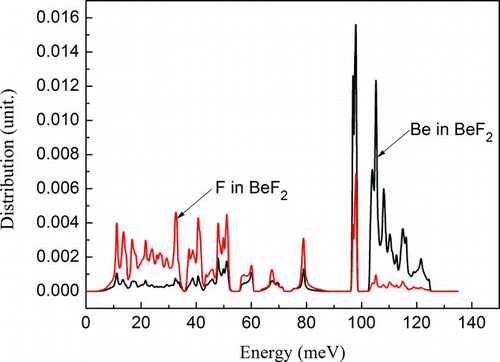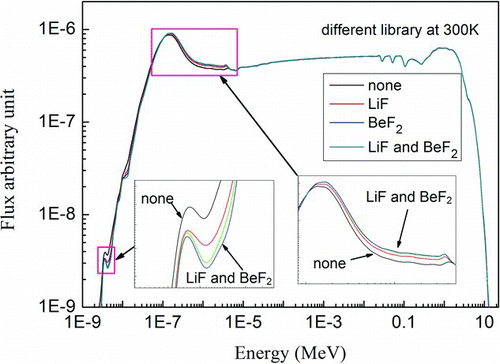Abstract
The influences of thermal neutron scattering data for BeF2 and LiF crystals on molten salt reactor physics are investigated in this work. Based on the structure parameters of BeF2 and LiF, the coherent scattering for both crystals is added to NJOY source code. The ENDF6 format thermal neutron scattering sub-libraries for both crystals are evaluated with their phonon spectra using LEAPR; the ACE format data are produced by NJOY subsequently. Finally, the effect of thermal neutron scattering of BeF2 and LiF crystals on k eff and spectrum are investigated. The result shows that thermal neutron scattering for bound state of BeF2 and LiF influence k eff and spectrum obviously. The elastic scattering cross section for bound state of crystals is smaller than free atom; it makes k eff decrease (1%–2%) and spectra be hardened. The higher temperature the bound state has, the smaller coherent elastic scattering cross section it gets; therefore, k eff decreases with temperature. It is suggested that the thermal neutron data of LiF and BeF2 should be taken into account for molten salt reactor.
1. Introduction
Molten salt reactor (MSR) is one of the six systems retained by Generation IV as a candidate for next generation of reactors which was partly developed in the 1950s and 1960s [Citation1, Citation2]. The characteristics of MSR are higher operation temperature, lower operation pressure [Citation3] and simpler fuel recycling with liquid fuel. Furthermore, this type of reactor is particularly well adapted to the thorium–uranium fuel cycle (233Th-U), which has the advantage of producing less minor actinides than the uranium–plutonium fuel cycle (238U-239Pu) [Citation4].
In molten salt reactor, the fuel (uranium fluoride, thorium fluoride, etc.) is dissolved in liquid BeF2 and LiF mixture (1:2–1:3 in mole concentration, also known as Flibe). It was suggested that the thermal neutron scattering of BeF2 and LiF should be taken into consideration [Citation5] though they were never treated as moderators traditionally. With the progress of some conceptual design, even engineering project of MSR, it is necessary to investigate the effect of thermal neutron scattering library (TSL) data of molten salt fuel, specially. As the first step, we investigate the thermal scattering of solid state for BeF2 and LiF.
For thermal neutron spectrum, moderator is considered as bound state and the free gas model is substituted by TSL sub-library in thermal region of spectrum. Most of the thermal neutron scattering sub-libraries used now were processed in the 1990s with LEAPR module [Citation6]. IKE re-evaluated H2O, D2O and ZrH in 2004 [Citation7], and North Carolina State University investigated the graphite thermal neutron scattering in detail [Citation8–Citation10]. In this paper, the thermal scattering cross section of LiF and BeF2 crystals are evaluated by updated LEAPR module based on the phonon distribution calculated by CASTEP [Citation11]. ACE format data of LiF and BeF2 for MCNP are made subsequently. Finally, microscopic cross sections are analyzed and macro results (k eff and spectrum) comparing are conducted.
2. Beryllium fluoride and lithium fluoride crystals
The structure parameters of LiF and BeF2 are necessary in determining form factors and Bragg edges which will be used in NJOY. They are also used to calculate the phonon distribution of crystals needed in LEAPR module. The lattice dynamics of BeF2 and LiF will be discussed in detail in the following calculation.
2.1. Structure of BeF2 and LiF
Beryllium fluoride is a kind of tetrahedral framework [Citation12] crystal which belongs to space group P3121. Its lattice parameters are given in Table . The basic vectors of lattice cell are a, b and c, and angles between vectors are α, β and γ. The structure of BeF2 is given in Figure . There are three beryllium atoms (indicated) and six fluorine atoms per unit cell. The fractional coordinates of atoms in unit cell are shown as follows [Citation13]:
Table 1 The lattice parameters of BeF2 and LiF crystals
Figure 1 Fragment of the BeF2 quartz structure (left) and its unit cell (right). There are three beryllium atoms and six fluorine atoms in one unit cell of BeF2
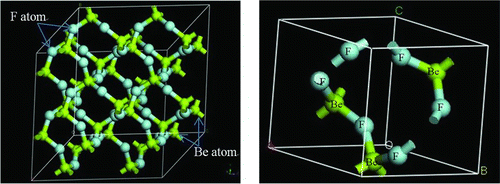
For lithium fluoride, it is a face centered cubic structure, there are four lithium atoms and four fluorine atoms in the unit cell as Figure shows [Citation14], and its fractional coordinates are described by:
2.2. Phonon distribution of BeF2 and LiF
In crystal, the real particle of lattice vibration is atom, and its quantum of collective vibration is described by phonon, which is a quasi-particle. Different energy (frequency) of phonon corresponds to different fundamental mode of vibration; so the concept of phonon spectra is useful in describing the lattices vibration. The calculation of phonon distribution for lithium and fluoride in LiF are performed using CASTEP, corresponding to the left and right of Figure , respectively. In view of the exchange-correlation of electrons (depend on both electron density and its gradient), the GGA (generalized gradient approximation) method was used.
Figure 3 Lithium (left) and fluorine (right) phonon distribution in LiF. 3*3*2 supercell is implemented and 5*5*5 k-mesh point is selected to confine the Brillion zone. Acoustic mode mainly contributed by fluorine and optic mode contributed by lithium
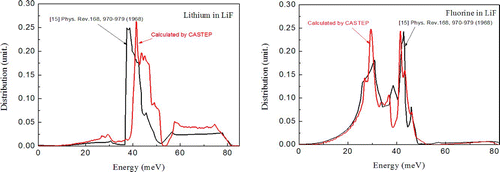
Considering the calculating speed and precision reason, 3*3*2 supercell is implemented and 5*5*5 k-mesh point is selected to confine the Brillion zone. Comparison of curves between the two diagrams of Figure shows that acoustic mode involves the motion mainly of F− ion, with very little contribution from Li+, and vice versa for the optic mode, which has the same trend as in Dolling et al.'s study [Citation15]. Note that the room temperature is chosen in this calculation.
Because of the unavailability of reference for BeF2, the phonon distribution of beryllium and fluoride in BeF2 are given in the same diagram, showed in Figure . It is also easy to find the acoustic modes, and optic modes are contributed by heavier ions (F−) and lighter ions (Be2+), respectively, which consist with LiF.
3. Thermal neutron scattering
For the fast neutron slowing down, the nucleus is treated as motionless; but when neutron is moderated to a low velocity (normally 4eV), the bound state of scattering nucleus will affect the collision process. Neutron may gain energy from vibration of nuclei and cause up-scattering, or it may transfer energy to materials and cause the excitation of bound state. Understanding this process is very important for thermal reactor design. Table shows the comparison of slow-down property of different moderators; here lithium is 7Li and beryllium is 9Be. All the physical quantities are computed in 0.0253eV with ENDF/B-VII library. In general, the slow-down property of beryllium in BeF2 is the best for Flibe. The poor moderating ratio of lithium can be explained by its stronger absorption cross section than other nuclei.
Table 2 The slow-down property comparison
There are two types of scattering when neutrons collide in solid state, coherent and incoherent scattering. Coherent scattering relates to the same system (same nuclei with the same positions and motions) which is related to the average scattering length; incoherent scattering arise from the random distribution of deviations of scattering lengths from their mean value [Citation16]. In addition, both coherent and incoherent scattering contains elastic and inelastic terms. Neutron doesn't lose energy in elastic scattering process, which is different from the process of neutron in higher energy elastic scattering. Inelastic scattering results in excitation (de-excitation) of the target corresponding to energy loss (gain). The thermal neutron scattering cross section was traditionally divided into three different parts [Citation6]:
Coherent elastic: Important for crystalline solids (like graphite, BeO, Be, BeF2 and LiF) | |||||
Incoherent elastic: Important for hydrogenous solids like solid methane, polyethylene and zirconium hydride | |||||
Inelastic: Important for all materials (including coherent and incoherent inelastic scattering). | |||||
For the thermal scattering data evaluation, scattering cross sections are written as:
The coherent elastic scattering cross section for free atom [Citation17] (needed in input card of LEAPR) and compounds [Citation18] (needed in source code of NJOY) are given in room temperature (see Table ).
Table 3 The coherent scattering cross section of free atom and compounds
4. Cross section analysis of thermal neutron scattering for BeF2 and LiF crystals
On the basis of phonon distribution from Figures and , the TSL data are evaluated by LEAPR module, and ACE cross sections are produced by NJOY subsequently, as shown in Figure . Since LiF and BeF2 are crystals, they have same form for elastic and inelastic scattering cross sections. Note that the elastic scatterings mainly are coherent elastic scatterings because the ratio of free atom coherent elastic scattering cross section to incoherent elastic scattering cross section is big enough.
Figure 5 Cross section of thermal neutron scattering of BeF2 (left) and LiF (right). Both BeF2 and LiF have the same trend. The inelastic scattering cross sections increase with temperature; on the contrary, elastic scattering cross sections decrease when temperature increase
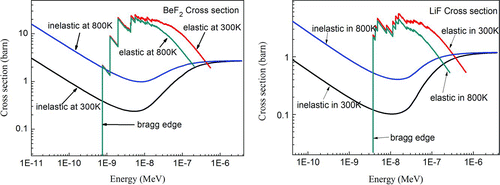
The initial energy of elastic scattering (coherent elastic scattering cross section vanish) corresponds to the first Bragg edge [Citation6,Citation19]. It then jumps sharply to a value, after that the cross section drops off as 1/E until certain energy, and then it takes another jump, and resumes its 1/E drop off again. There is nothing left but an asymptotic 1/E decreases at high energies. The elastic scattering cross section of 800 K is smaller than that of 300 K, and the discrepancy of elastic scattering cross section between these two temperatures increases as incident neutron energy increases; on the contrary, the higher temperature we choose, the bigger inelastic scattering cross section we get, and the discrepancy between 300 and 800 K reduces as energy increases.
5. Effect of thermal scattering for BeF2 and LiF crystals on reactor physics
The influences of different TSL data of BeF2 and LiF crystals on reactor physics are investigated with a molten salt reactor model [Citation20], as given in Table . It is easy to find k eff decrease when adding thermal neutron scattering of compounds. It also found that k eff at 800K is smaller than that at 300K, this mainly results from the fewer fission neutrons moderated to thermal energy at 800K due to the smaller elastic scattering cross section.
Table 4 Effect of different TSL data of BeF2 and LiF crystals on k eff
The influence of thermal neutron scattering on spectrum is investigated and the results are shown in Figure . The elastic scattering cross section makes spectrum getting hardened (see the enlarged part in Figure , the flux for low energy neutrons decrease and for high energy neutrons increase). In general, BeF2 has stronger impact on k eff and spectrum than LiF, which is consistent with the phenomenon shown in k eff calculations.
6. Conclusion and plan
The effect of thermal neutron scattering of BeF2 and LiF crystals on reactor physics is not negligible, and the influence of BeF2 on reactor physics is stronger than LiF. In the macro and micro computation of this work, the decrease of elastic scattering cross section result in k eff lessen and spectrum harden, this phenomenon is more obvious for BeF2 because of its excellent moderating property.
The Flibe in molten salt reactor is liquid rather than solid, it is suggested that some correction should be done in LEAPR input parameter in the next step, and molecular dynamics should be used for the ion translation. Finally, the inelastic scattering cross section should be investigated carefully for the complicated motion of ions.
Acknowledgements
This work is supported by the Th-U fuel Physics Term (No. XDA02010100) under the Chinese TMSR Strategic Pioneer Sci.&Tech. Project. The authors also wish to thank Dr. Chaobin Chen and Dr. Lipeng Wang for their helpful discussion when processing thermal neutron scattering data.
References
- Bettis , E S , Schroeder , R W , Cristy , G A , Savage , H W , Affel , R G and Hemphill , L F . 1957 . The aircraft reactor experiment-design and construction . Nucl Sci Eng , 2 : 804 – 825 .
- Haubenreich , P N and Engel , J R . 1970 . Experiment with the molten-salt reactor experiment . Nucl Appl Technol , 8 : 118 – 136 .
- 1958 . MacPherson HG. Fluid fuel reactors , 567 – 568 . Massachusetts , , USA : Addison-Wesley .
- Merle-Lucotte , E , Heuer , D , Allibert , M , Ghetta , V and Le Brun , C . 2008 . “ Introduction to the physics of molten salt reactors ” . In NATO Science for Peace and Security Series B: Physics and Biophysics , 501 – 521 . Berlin , Heidelberg : Springer .
- Ergen , W K , Callihan , A D , Mills , C B and Scott , D . 1957 . The aircraft reactor experiment-physics . Nucl Sci Eng , 2 : 826 – 840 .
- 1994 . MacFarlane RE. New thermal neutron scattering files for ENDF/B-VI release 2, LA-12639-MS , Los Alamos, NM , , USA : Los Alamos National Laboratory .
- Mattes , M and Keinert , J . 2005 . Thermal neutron scattering data for the moderator materials H2O, D2O and ZrHx in ENDF-6 format and as ACE library for MCNP(X) codes, INDC(NDS)-0470 , IKE, University of Stuttgart .
- Difilippo , F C , Renier , J P and Hawari , A I . 2002 . “ Benchmarks for the scattering kernel of graphite ” . In International Conference on the New Frontiers of Nuclear Technology; 2002 October 7–10. Seoul , PHYSOR .
- Hawari , A I and Al-Qasir , I I . 2007 . Investigation of the impact of simple carbon interstitial formations on thermal neutron scattering in graphite . Nucl Sci Eng , 155 : 449 – 462 .
- Hawari , A I . 2008 . Final project report, DE-FR07-02SF225142008 , North Carolina , , USA : North Carolina State University .
- 2001 . Accelrys Inc., CASTEP users guide , San Diego : Accelrys Inc. .
- Awijnenburg , M A , Corà , F and Bell , R G . 2008 . Isomorphism of anhydrous tetrahedral halides and silicon chalcogenides: Energy landscape ofcrystalline BeF2, BeCl2, SiO2, and SiS2 . J Am Chem Soc , 130 : 11082 – 11087 .
- Ghalsasi , P and Ghalsasi , P S . 2011 . Single crystal X-ray structure of BeF2: α-quartz . Inorg Chem. , 50 : 86 – 89 .
- Recker , K. , Wallrafen , F. and Dupre , K. 1988 . Directional solidification of the LiF-LiBaF3 eutectic . Naturwissenschaften , 75 : 156 – 157 .
- Dolling , G , Smith , H G , Mnicklow , R , Vijayaraghavan , P R and Wilkinson , M K . 1968 . Lattice dynamics of lithium fluoride . Phys Rev , 168 : 970 – 979 .
- Squires , G L . 1978 . Introduction to the theory of thermal neutron scattering , 22 – 23 . Cambridge , UK : Cambridge University Press . ISBN 0521218845
- Sears , V F . 1992 . Neutron scattering lengths and cross sections . Neutron News , 3 : 29 – 37 . http://www.ncnr.nist.gov/resources/n-lengths/list.html
- Shull , C G and Wollan , E Q . 1951 . Coherent scattering amplitudes as determined by neutron diffraction . Phys Rev. , 81 : 527 – 535 . Online calculator: http://www.ncnr.nist.gov/resources/sldcalc.html.
- Santisteban , J R , Edwards , L , Steuwer , A and Withers , P J . 2001 . Time-of-flight neutron transmission diffraction . J Appl Crystallogr , 34 : 289
- Price , B E , Ball , S J , Engel , J R , Haubenreich , P N and Kerlin , T W . 1968 . “ Zero-power physics experiments on the molten-salt reactor experiment, ORNL-4233 ” . Oak Ridge, TN , , USA : Oak Ridge National Laboratory .
